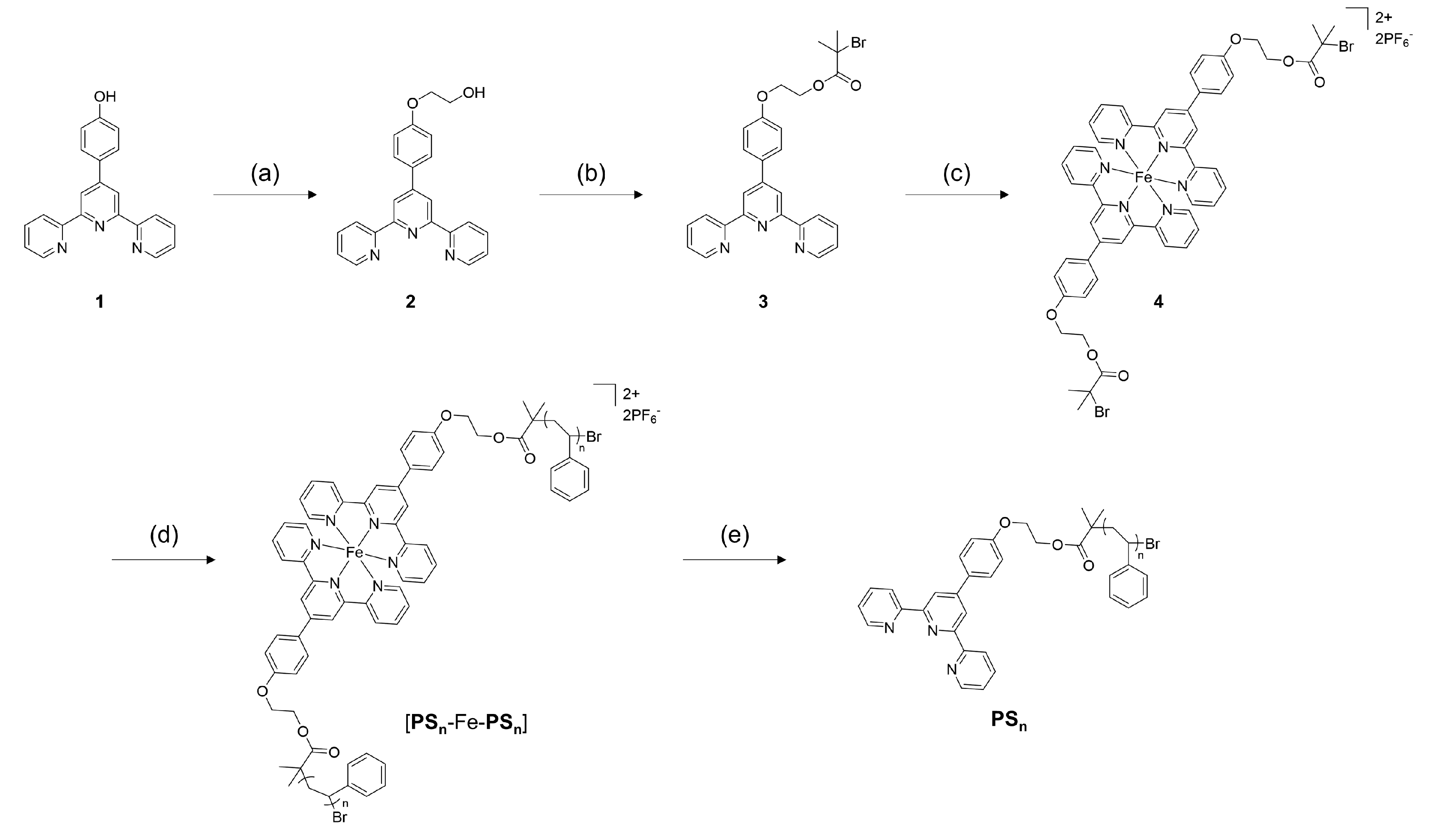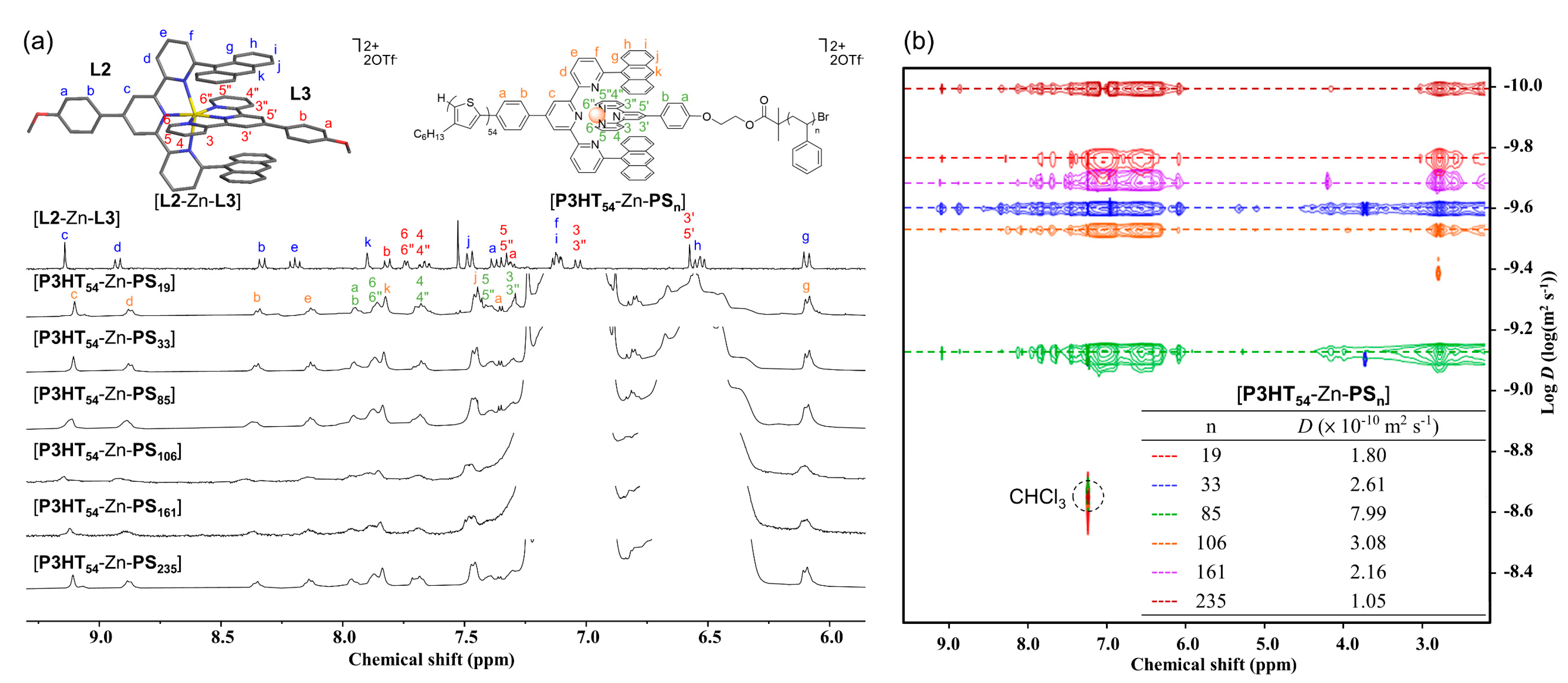Synthesis of Terpyridine End-Modified Polystyrenes through ATRP for Facile Construction of Metallo-Supramolecular P3HT-b-PS Diblock Copolymers
Abstract
:1. Introduction
2. Materials and Methods
2.1. Materials
2.2. Methods
2.3. General Procedure for Complexation Reactions
3. Results and Discussion
4. Conclusions
Supplementary Materials
Author Contributions
Funding
Acknowledgments
Conflicts of Interest
References
- Schubert, U.S.; Eschbaumer, C. Macromolecules Containing Bipyridine and Terpyridine Metal Complexes: Towards Metallosupramolecular Polymers. Angew. Chem. Int. Ed. 2002, 41, 2892–2926. [Google Scholar] [CrossRef]
- Fraser, C.L.; Smith, A.P.; Wu, X. Metal Template-Assisted Block Copolymer Synthesis: Use of Solvent Polarity to Control Chain Conformation and Reactivity at the Metal Core. J. Am. Chem. Soc. 2000, 122, 9026–9027. [Google Scholar] [CrossRef]
- Corbin, P.S.; Webb, M.P.; McAlvin, J.E.; Fraser, C.L. Biocompatible Polyester Macroligands: New Subunits for the Assembly of Star-Shaped Polymers with Luminescent and Cleavable Metal Cores. Biomacromolecules 2001, 2, 223–232. [Google Scholar] [CrossRef] [PubMed]
- Bender, J.L.; Corbin, P.S.; Fraser, C.L.; Metcalf, D.H.; Richardson, F.S.; Thomas, E.L.; Urbas, A.M. Site-Isolated Luminescent Europium Complexes with Polyester Macroligands: Metal-Centered Heteroarm Stars and Nanoscale Assemblies with Labile Block Junctions. J. Am. Chem. Soc. 2002, 124, 8526–8527. [Google Scholar] [CrossRef] [PubMed]
- Schubert, U.S.; Eschbaumer, C. Functionalized Oligomers and Copolymers with Metal Complexing Segments: A Simple and High Yield Entry Towards 2,2′:6′,2″-Terpyridine Monofunctionalized Telechelics. Macromol. Symp. 2001, 163, 177–188. [Google Scholar] [CrossRef]
- Gohy, J.-F.; Lohmeijer, B.G.G.; Schubert, U.S. Metallo-Supramolecular Block Copolymer Micelles. Macromolecules 2002, 35, 4560–4563. [Google Scholar] [CrossRef]
- Chiper, M.; Meier, M.A.R.; Kranenburg, J.M.; Schubert, U.S. New Insights into Nickel(II), Iron(II), and Cobalt(II) Bis-Complex-Based Metallo-Supramolecular Polymers. Macromol. Chem. Phys. 2007, 208, 679–689. [Google Scholar] [CrossRef]
- Ott, C.; Wouters, D.; Thijs, H.M.L.; Schubert, U.S. New Preparation and Purification Methods for Metallo-Supramolecular Block Copolymers. J. Inorg. Organomet. Polym. Mater. 2007, 17, 241–249. [Google Scholar] [CrossRef]
- Landsmann, S.; Winter, A.; Chiper, M.; Fustin, C.-A.; Hoeppener, S.; Wouters, D.; Gohy, J.-F.; Schubert, U.S. Poly(dimethylsiloxane)-Substituted 2,2′:6,2″-Terpyridines: Synthesis and Characterization of New Amphiphilic Supramolecular Diblock Copolymers. Macromol. Chem. Phys. 2008, 209, 1666–1672. [Google Scholar] [CrossRef]
- Gohy, J.-F.; Chiper, M.; Guillet, P.; Fustin, C.-A.; Hoeppener, S.; Winter, A.; Hoogenboom, R.; Schubert, U.S. Self-Organization of Rod–Coil Tri- and Tetra-Arm Star Metallo-Supramolecular Block Copolymers in Selective Solvents. Soft Matter 2009, 5, 2954–2961. [Google Scholar] [CrossRef]
- Gohy, J.-F.; Ott, C.; Hoeppener, S.; Schubert, U.S. Multicompartment Micelles From a Metallo-Supramolecular Tetrablock Quatercopolymer. Chem. Commun. 2009, 6038–6040. [Google Scholar] [CrossRef] [PubMed]
- Mugemana, C.; Guillet, P.; Hoeppener, S.; Schubert, U.S.; Fustin, C.-A.; Gohy, J.-F. Metallo-Supramolecular Diblock Copolymers Based on Heteroleptic Cobalt(III) and Nickel(II) Bis-terpyridine Complexes. Chem. Commun. 2010, 46, 1296–1298. [Google Scholar] [CrossRef] [PubMed]
- Brzeziński, M.; Kacprzak, A.; Calderón, M.; Seiffert, S. Metallo-Polymer Chain Extension Controls the Morphology and Release Kinetics of Microparticles Composed of Terpyridine-Capped Polylactides and Their Stereocomplexes. Macromol. Rapid Commun. 2017, 38, 1600790. [Google Scholar] [CrossRef] [PubMed]
- Ambade, A.V.; Yang, S.K.; Weck, M. Supramolecular ABC Triblock Copolymers. Angew. Chem. 2009, 121, 2938–2942. [Google Scholar] [CrossRef]
- Moughton, A.O.; Stubenrauch, K.; O’Reilly, R.K. Hollow Nanostructures from Self-Assembled Supramolecular Metallo-Triblock Copolymers. Soft Matter 2009, 5, 2361–2370. [Google Scholar] [CrossRef]
- Elacqua, E.; Manning, K.B.; Lye, D.S.; Pomarico, S.K.; Morgia, F.; Weck, M. Supramolecular Multiblock Copolymers Featuring Complex Secondary Structures. J. Am. Chem. Soc. 2017, 139, 12240–12250. [Google Scholar] [CrossRef]
- Lye, D.S.; Xia, Y.; Wong, M.Z.; Wang, Y.; Nieh, M.-P.; Weck, M. ABC Supramolecular Triblock Copolymer by ROMP and ATRP. Macromolecules 2017, 50, 4244–4255. [Google Scholar] [CrossRef]
- Deng, R.; Milton, M.; Pomarico, S.K.; Weck, M. Synthesis of a Heterotelechelic Helical Poly(methacrylamide) and Its Incorporation Into a Supramolecular Triblock Copolymer. Polym. Chem. 2019, 10, 5087–5093. [Google Scholar] [CrossRef]
- He, Y.-J.; Tu, T.-H.; Su, M.-K.; Yang, C.-W.; Kong, K.V.; Chan, Y.-T. Facile Construction of Metallo-Supramolecular Poly(3-hexylthiophene)-block-Poly(ethylene oxide) Diblock Copolymers via Complementary Coordination and Their Self-Assembled Nanostructures. J. Am. Chem. Soc. 2017, 139, 4218–4224. [Google Scholar] [CrossRef]
- Zhou, G.; Harruna, I.I. Synthesis and Characterization of Bis(2,2′:6′,2″-terpyridine)ruthenium(II)-Connected Diblock Polymers via RAFT Polymerization. Macromolecules 2005, 38, 4114–4123. [Google Scholar] [CrossRef]
- Zhang, L.; Zhang, Y.; Chen, Y. Synthesis of Bis(2,2′:6′,2″-terpyridine)-Terminated Telechelic Polymers by RAFT Polymerization and Ruthenium–Polymer Complexation Thereof. Eur. Polym. J. 2006, 42, 2398–2406. [Google Scholar] [CrossRef]
- Elkin, T.; Copp, S.M.; Hamblin, R.L.; Martinez, J.S.; Montaño, G.A.; Rocha, R.C. Synthesis of Terpyridine-Terminated Amphiphilic Block Copolymers and Their Self-Assembly into Metallo-Polymer Nanovesicles. Materials 2019, 12, 601. [Google Scholar] [CrossRef] [PubMed] [Green Version]
- Aamer, K.A.; Tew, G.N. Synthesis of Terpyridine-Containing Polymers with Blocky Architectures. Macromolecules 2004, 37, 1990–1993. [Google Scholar] [CrossRef]
- Lohmeijer, B.G.G.; Schubert, U.S. The LEGO Toolbox: Supramolecular Building Blocks by Nitroxide-Mediated Controlled Radical Polymerization. J. Polym. Sci. A Polym. Chem. 2005, 43, 6331–6344. [Google Scholar] [CrossRef]
- Tew, G.N.; Aamer, K.A.; Shunmugam, R. Incorporation of Terpyridine into the Side Chain of Copolymers to Create Multi-Functional Materials. Polymer 2005, 46, 8440–8447. [Google Scholar] [CrossRef]
- Ott, C.; Lohmeijer, B.G.G.; Wouters, D.; Schubert, U.S. Terpyridine-Terminated Homo and Diblock Copolymer LEGO Units by Nitroxide-Mediated Radical Polymerization. Macromol. Chem. Phys. 2006, 207, 1439–1449. [Google Scholar] [CrossRef]
- Heller, M.; Schubert, U.S. Optically Active Supramolecular Poly(L-lactide)s End-Capped with Terpyridine. Macromol. Rapid Commun. 2001, 22, 1358–1363. [Google Scholar] [CrossRef]
- Hofmeier, H.; Hoogenboom, R.; Wouters, M.E.L.; Schubert, U.S. High Molecular Weight Supramolecular Polymers Containing Both Terpyridine Metal Complexes and Ureidopyrimidinone Quadruple Hydrogen-Bonding Units in the Main Chain. J. Am. Chem. Soc. 2005, 127, 2913–2921. [Google Scholar] [CrossRef]
- Winter, A.; Schubert, U.S. New Polyester-Based Terpyridine Macroligands and Their Blue Iron(II) Complexes. Macromol. Chem. Phys. 2007, 208, 1956–1964. [Google Scholar] [CrossRef]
- Tzanetos, N.P.; Andreopoulou, A.K.; Kallitsis, J.K. Side-Chain Terpyridine Polymers through Atom Transfer Radical Polymerization and Their Ruthenium Complexes. J. Polym. Sci. A 2005, 43, 4838–4848. [Google Scholar] [CrossRef]
- Efkianakis, E.K.; Tzanetos, N.P.; Chochos, C.L.; Andreopoulou, A.K.; Kallitsis, J.K. End-Functionalization of Semiconducting Species with Dendronized Terpyridine–Ru(II)–Terpyridine Complexes. J. Polym. Sci. A Polym. Chem. 2009, 47, 1939–1952. [Google Scholar] [CrossRef]
- Lamba, J.J.S.; Fraser, C.L. Synthesis of Metal-Centered Star-Shaped Polyoxazolines Using Fe(II) and Ru(II) Tris-bipyridine Derivatives as Multifunctional Initiators. J. Am. Chem. Soc. 1997, 119, 1801–1802. [Google Scholar] [CrossRef]
- McAlvin, J.E.; Fraser, C.L. Polymerization of 2-Ethyl-2-oxazoline Using Di-, Tetra-, and Hexafunctional Ruthenium Tris(bipyridine) Metalloinitiators. Macromolecules 1999, 32, 6925–6932. [Google Scholar] [CrossRef]
- Fraser, C.L.; Smith, A.P. Metal Complexes with Polymeric Ligands: Chelation and Metalloinitiation Approaches to Metal Tris(bipyridine)-Containing Materials. J. Polym. Sci. A 2000, 38, 4704–4716. [Google Scholar] [CrossRef]
- Johnson, R.M.; Corbin, P.S.; Ng, C.; Fraser, C.L. Poly(methyl methacrylates) with Ruthenium Tris(bipyridine) Cores via NiBr2(PR3)2-Catalyzed Atom Transfer Radical Polymerization (ATRP). Macromolecules 2000, 33, 7404–7412. [Google Scholar] [CrossRef]
- Wu, X.; Fraser, C.L. Architectural Diversity via Metal Template-Assisted Polymer Synthesis: A Macroligand Chelation Approach to Linear and Star-Shaped Polymeric Ruthenium Tris(bipyridine) Complexes. Macromolecules 2000, 33, 4053–4060. [Google Scholar] [CrossRef]
- Wu, X.; Collins, J.E.; McAlvin, J.E.; Cutts, R.W.; Fraser, C.L. Ruthenium Tris(bipyridine)-Centered Linear and Star-Shaped Polystyrenes: Making Atom Transfer Radical Polymerization and Metal Complex Initiators Compatible. Macromolecules 2001, 34, 2812–2821. [Google Scholar] [CrossRef]
- Johnson, R.M.; Fraser, C.L. Iron Tris(bipyridine)-Centered Star Block Copolymers: Chelation of Triblock Macroligands Generated by ROP and ATRP. Macromolecules 2004, 37, 2718–2727. [Google Scholar] [CrossRef]
- Johnson, R.M.; Fraser, C.L. Metalloinitiation Routes to Biocompatible Poly(lactic acid) and Poly(acrylic acid) Stars with Luminescent Ruthenium Tris(bipyridine) Cores. Biomacromolecules 2004, 5, 580–588. [Google Scholar] [CrossRef]
- Hoogenboom, R.; Schubert, U.S. The Use of (Metallo-)Supramolecular Initiators for Living/Controlled Polymerization Techniques. Chem. Soc. Rev. 2006, 35, 622–629. [Google Scholar] [CrossRef]
- Collins, J.E.; Fraser, C.L. Transition Metals as Templates for Multifunctional Initiators: Bulk Atom Transfer Radical Polymerization of Styrene Using Di-, Tetra- and Hexafunctional Ruthenium Tris(bipyridine) Reagents. Macromolecules 1998, 31, 6715–6717. [Google Scholar] [CrossRef]
- Viau, L.; Even, M.; Maury, O.; Haddleton, D.M.; Le Bozec, H. New Star-Shaped Metallo-Polymeric Chromophores. Macromol. Rapid Commun. 2003, 24, 630–635. [Google Scholar] [CrossRef]
- Bahrami, K.; Khodaei, M.M.; Meibodi, F.S. Suzuki and Heck Cross-Coupling Reactions Using Ferromagnetic Nanoparticle-Supported Palladium Complex as an Efficient and Recyclable Heterogeneous Nanocatalyst in Sodium Dodecylsulfate Micelles. Appl. Organomet. Chem. 2017, 31, e3627. [Google Scholar] [CrossRef]
- Kong, L.; Han, X.; Jiao, P. Catalytic Asymmetric Diels–Alder Reactions Involving Aryl Vinyl Ketones. Chem. Commun. 2014, 50, 14113–14116. [Google Scholar] [CrossRef]
- Scott, J.E.; Kyffin, T.W. Demineralization in Organic Solvents by Alkylammonium Salts of Ethylenediaminetetra-Acetic Acid. Biochem. J. 1978, 169, 697–701. [Google Scholar] [CrossRef]
- Campo, B.J.; Bevk, D.; Kesters, J.; Gilot, J.; Bolink, H.J.; Zhao, J.; Bolsée, J.-C.; Oosterbaan, W.D.; Bertho, S.; D’Haen, J.; et al. Ester-Functionalized Poly(3-alkylthiophene) Copolymers: Synthesis, Physicochemical Characterization and Performance in Bulk Heterojunction Organic Solar Cells. Org. Electron. 2013, 14, 523–534. [Google Scholar] [CrossRef]
- Wang, S.-Y.; Fu, J.-H.; Liang, Y.-P.; He, Y.-J.; Chen, Y.-S.; Chan, Y.-T. Metallo-Supramolecular Self-Assembly of a Multicomponent Ditrigon Based on Complementary Terpyridine Ligand Pairing. J. Am. Chem. Soc. 2016, 138, 3651–3654. [Google Scholar] [CrossRef]
- Tu, T.-H.; Sakurai, T.; Seki, S.; Ishida, Y.; Chan, Y.-T. Towards Macroscopically Anisotropic Functionality: Oriented Metallo-supramolecular Polymeric Materials Induced by Magnetic Fields. Angew. Chem. Int. Ed. 2020. [Google Scholar] [CrossRef]
- Meier, M.A.R.; Lohmeijer, B.G.G.; Schubert, U.S. Characterization of Defined Metal-Containing Supramolecular Block Copolymers. Macromol. Rapid Commun. 2003, 24, 852–857. [Google Scholar] [CrossRef]
- Francis, R.; Lepoittevin, B.; Taton, D.; Gnanou, Y. Toward an Easy Access to Asymmetric Stars and Miktoarm Stars by Atom Transfer Radical Polymerization. Macromolecules 2002, 35, 9001–9008. [Google Scholar] [CrossRef]
- Laird, D.W.; Loewe, R.S.; Ewbank, P.C.; Liu, J.; Zhai, L.; McCullough, R. Mechanistic Aspects of Regioregularity in Head-to-Tail Coupled Poly(3-alkylthiophes). Polymer Prepr. 2001, 42, 556–557. [Google Scholar]
- Tkachov, R.; Senkovskyy, V.; Komber, H.; Kiriy, A. Influence of Alkyl Substitution Pattern on Reactivity of Thiophene-Based Monomers in Kumada Catalyst-Transfer Polycondensation. Macromolecules 2011, 44, 2006–2015. [Google Scholar] [CrossRef]
- Huang, K.-H.; Tu, T.-H.; Wang, S.-C.; Chan, Y.-T.; Hsu, C.-C. Micelles Protect Intact Metallo-Supramolecular Block Copolymer Complexes from Solution to Gas Phase during Electrospray Ionization. Anal. Chem. 2018, 90, 7691–7699. [Google Scholar] [CrossRef] [PubMed]
- Bakkour, Y.; Darcos, V.; Li, S.; Coudane, J. Diffusion Ordered Spectroscopy (DOSY) as a Powerful Tool for Amphiphilic Block Copolymer Characterization and for Critical Micelle Concentration (CMC) Determination. Polym. Chem. 2012, 3, 2006–2010. [Google Scholar] [CrossRef]
- Yu, X.; Xiao, K.; Chen, J.; Lavrik, N.V.; Hong, K.; Sumpter, B.G.; Geohegan, D.B. High-Performance Field-Effect Transistors Based on Polystyrene-b-Poly(3-hexylthiophene) Diblock Copolymers. ACS Nano 2011, 5, 3559–3567. [Google Scholar] [CrossRef]
- Kato, H.; Saito, T.; Nabeshima, M.; Shimada, K.; Kinugasa, S. Assessment of Diffusion Coefficients of General Solvents by PFG-NMR: Investigation of the Sources Error. J. Magn. Reson. 2006, 180, 266–273. [Google Scholar] [CrossRef]





| Entry | [4]:[styrene]:[CuBr]:[PMDETA] a | Conversion (%) | Mn,NMRb | DP b | Mn,GPCc | Mw/Mnc |
|---|---|---|---|---|---|---|
| PS19 | 1:100:3:3 | 31 | 2700 | 19 | 1900 | 1.14 |
| PS33 | 1:200:3:3 | 48 | 4000 | 33 | 3600 | 1.13 |
| PS85 | 1:200:3:3 | 55 | 9000 | 85 | 7900 | 1.21 |
| PS106 | 1:400:3:3 | 46 | 11,100 | 106 | 11,900 | 1.14 |
| PS161 | 1:800:3:3 | 33 | 16,700 | 161 | 16,200 | 1.17 |
| PS235 | 1:800:3:3 | 64 | 24,500 | 235 | 22,000 | 1.26 |
Publisher’s Note: MDPI stays neutral with regard to jurisdictional claims in published maps and institutional affiliations. |
© 2020 by the authors. Licensee MDPI, Basel, Switzerland. This article is an open access article distributed under the terms and conditions of the Creative Commons Attribution (CC BY) license (http://creativecommons.org/licenses/by/4.0/).
Share and Cite
Tu, T.-H.; Chan, Y.-T. Synthesis of Terpyridine End-Modified Polystyrenes through ATRP for Facile Construction of Metallo-Supramolecular P3HT-b-PS Diblock Copolymers. Polymers 2020, 12, 2842. https://doi.org/10.3390/polym12122842
Tu T-H, Chan Y-T. Synthesis of Terpyridine End-Modified Polystyrenes through ATRP for Facile Construction of Metallo-Supramolecular P3HT-b-PS Diblock Copolymers. Polymers. 2020; 12(12):2842. https://doi.org/10.3390/polym12122842
Chicago/Turabian StyleTu, Tsung-Han, and Yi-Tsu Chan. 2020. "Synthesis of Terpyridine End-Modified Polystyrenes through ATRP for Facile Construction of Metallo-Supramolecular P3HT-b-PS Diblock Copolymers" Polymers 12, no. 12: 2842. https://doi.org/10.3390/polym12122842
APA StyleTu, T.-H., & Chan, Y.-T. (2020). Synthesis of Terpyridine End-Modified Polystyrenes through ATRP for Facile Construction of Metallo-Supramolecular P3HT-b-PS Diblock Copolymers. Polymers, 12(12), 2842. https://doi.org/10.3390/polym12122842





